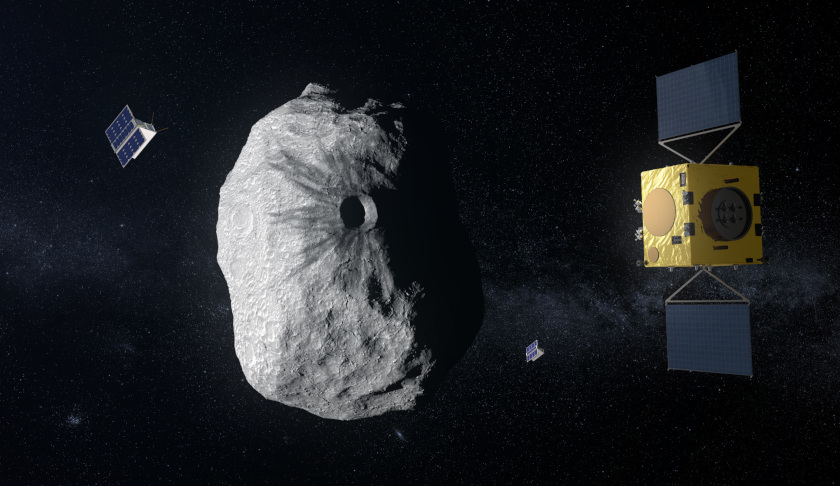
Japan’s Hayabusa2 spacecraft dropped a copper projectile at very high speed in an attempt to form a crater on asteroid Ryugu. A much bigger asteroid impact is planned for the coming decade, involving an international double-spacecraft mission.
Hayabusa2 released an experiment called the ‘Small Carry-on Impactor’ (SCI), carrying a plastic explosive charge that shot a 2.5-kilogram copper projectile at the surface of the 900-metre diameter Ryugu asteroid at a velocity of around 2km/s. The objective is to uncover subsurface material to be brought back to Earth for detailed analysis.
Patrick Michel, CNRS director of research of France’s Côte d'Azur Observatory, serving as co-investigator and interdisciplinary scientist on the Japanese mission, said, "We are expecting it to form a distinctive crater. But we don’t know for sure yet, because Hayabusa2 was moved around to the other side of Ryugu, for maximum safety."
According to simulations, the crater is predicted to have a roughly two-metre diameter, although the modelling of impacts in such a low-gravity environment is extremely challenging.
It should appear darker than the surrounding surface, based on a February touch-and-go sampling operation when Hayabusa2’s thrusters dislodged surface dust to expose blacker material underneath.
"So the plan is to wait until this Thursday, 25 April, to go back and image the crater. We expect that very small fragments will meanwhile have their orbits disrupted by solar radiation pressure – the slow but persistent push of sunlight itself. In the meantime, we’ve also been downloading images from a camera called DCAM3 that accompanied the SCI payload to see if it caught a glimpse of the crater and the early ejecta evolution," Michel explained.
The success of this mission paves the way for the similar US Double Asteroid Redirect Test (DART) spacecraft test in late 2022.
Michel added, "In late 2022, the US Double Asteroid Redirect Test or DART spacecraft will crash into the smaller of the two Didymos asteroids. As with Hayabusa2’s SCI test, it should form a very distinct crater and expose subsurface material in an even lower gravity environment, but its main purpose is to actually divert the orbit of the 160-metre diameter ‘Didymoon’ asteroid in a measurable way."
The DART spacecraft will have a mass of 550 kilograms, and will strike Didymoon at 6km/s. Striking an asteroid five times smaller with a spacecraft more than 200 times larger and moving three times faster should deliver sufficient impact energy to achieve the first ever asteroid deflection experiment for planetary defence.
Didymoon will also be by far the smallest asteroid ever explored, so will offer insights into the cohesion of material in an environment where gravity is more than a million times weaker than our own – an alien situation extremely challenging to simulate.
In 2004, NASA’s Deep Impact spacecraft launched an impactor into comet Tempel 1. The body was subsequently revisited, but the artificial crater was hard to pinpoint – largely because the comet had flown close to the sun in the meantime, and its heating would have modified the surface.
Hera will visit Didymoon around four years after DART’s impact, but because it is an inactive asteroid in deep space, no such modification will occur.
“The crater will still be ‘fresh’ for Hera,” Michel concluded.
Receive the latest developments and updates on Australia’s space industry direct to your inbox. Subscribe today to Space Connect here.












